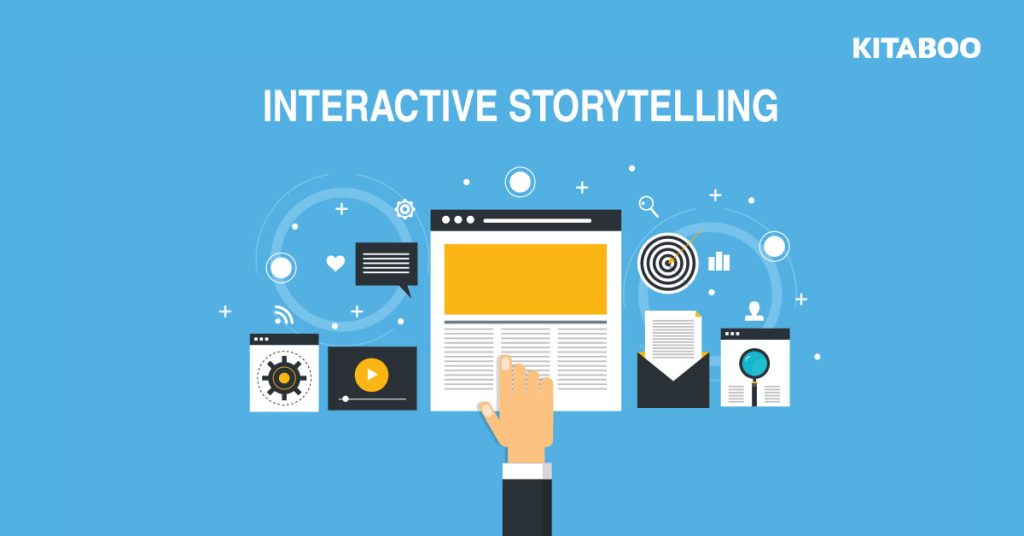
What Is Interactive Storytelling and Why It Is Important?
Summarize this blog with your favorite AI:
Why do people read? How do ardent readers manage to spend hours sitting with a book?
The reasons are numerous.
People read fictional stories to escape reality or take a creative break from everyday life. Some people read to gain perspective and develop skills like discipline, self-awareness, learning agility, empathy, etc.
Hence, fictional stories go a long way in establishing a productive and creative connection between people and ideas.
In the digital world of immense technological advancement, storytelling has taken numerous new forms like a non-linear, nested loop, in media res, false start, transmedia, deep media, etc.
These interactive storytelling techniques can also be identified in traditional fictional books, but digital media have greatly transformed viewer and reader-centric techniques.
For instance, Netflix’s 2018 science fiction drama Black Mirror: Bandersnatch allowed viewers to choose from a variety of endings, making it highly interactive and engaging.
What Is Interactive Storytelling?
Interactive storytelling is a form of narrative technique in which the plotline may or may not be determined, and the audience plays a huge role in how they perceive the story.
These techniques are mostly used in digital entertainment for a variety of techniques like improving information retention, making data easily accessible, increasing leads and sales, etc.
All the traditional characteristics are present in interactive stories, like settings, characters, imagery, symbolism, etc., along with some extra elements like drama manager, user model, and agent model. These new rudiments play a huge role in altering the connection between the story and the audience and determining what the viewers will take away from it.
Interactive storytelling, in its process, plays with a variety of fields like psychology, sociology, linguistics, artificial intelligence, cognitive science, literature, etc. Its interdisciplinary nature gives birth to numerous technical challenges, but eLearning designing has been doing an incredible job of overcoming these obstacles.
Benefits of Interactive Storytelling
As mentioned earlier, interactive storytelling creatively engages viewers. Viewers will feel like they are in control of the narrative, breaking the fourth wall between the author and viewers/readers.
Some additional benefits of interactive storytelling are:
1. Boosted Popularity and Acceptance of eLearning
Earlier eLearning only referred to digital modules that learners could access on their screen without presenting themselves in a classroom or physical training scenario. These digital modules used to be simple PDF documents with information overload.
However, interactive storytelling has revolutionized eLearning.
eLearning is now experimenting with various formats like quizzes, infographics, eBooks with video content, video games, digital video storytelling, etc. This way, learners become more motivated to engage with the data and retain it longer.
The higher the interactive element more are the chances of successful learning.
2. Develops an Emotional Connection
The more readers/viewers will engage with the story, the better their chances of building an emotional connection will be.
For instance, in Janice Pariat’s novel The Nine-Chambered Heart, the name, age, and gender of the protagonist have not been mentioned. It is upon the readers to interpret these factors while they are engaging with the story.
This allows them to empathize better with the protagonist and understand their fears, achievements, personal bonds, etc.
3. Encourages Further Research
Once the audience and viewers have been successful in building a personal connection with the narrative, inquisitiveness follows. The narrative will leave them once it is finished, but they won’t be able to forget about it quickly.
Hence, the probability of them researching more about the narrative elements later are high. This feature is highly beneficial for student classroom learning and employee training and development.
4. Fosters Collaboration
If viewers work in a group to engage with an interactive story, they will also collaborate and communicate. Even if one viewer/learner takes the initiative to present their opinions, input from others will follow soon.
How to Create Interactive Stories?
Now that you know what interactive stories are and what their benefits are, you can think about creating your own stories. Here are some tips you can follow:
- Do not hesitate to use software for creating interactive stories. This software comes with various tools like ideation, script writing & editing, video editing, character creation, etc. If you are not ready to or sure about investing in a paid version, you can trial-run some open-source software available online.
- Narrow down on a setting before you begin to plan the other elements of your story like aim/objective, characters, symbolism, moral of the story, etc. This will help you narrow down ideas and not get stuck on one element of the story for a prolonged duration.
- Build space in your story to welcome varied perspectives of readers. The main highlight of interactive storytelling is allowing readers a place of their own in the narrative. You can do this in various ways, like having multiple endings, leaving characters unnamed, adding prompt quizzes, including cues and hints through symbols, etc.
- Make a conscious effort to collaborate with others in the field. It might be a solo project, but a little help hurts one. Discuss and brainstorm your ideas with friends, family, and colleagues. You never know how and when inspiration can strike you.
- Undertaking an interactive storytelling technique can be exhausting, but do not lose hope. Remember, it is not just a sprint; it’s a marathon. Stay true to your project and continue putting in hard work. Soon results will follow.
Closing Thoughts
Even in this modern digital world, the real essence of storytelling will never be left behind. The forms of storytelling will change now and then, but stories will continue to incite strong emotional responses from viewers and readers.
If you are looking to teach your student, train your employees, or simply advertise your brand, equip yourself with modern-day interactive storytelling. Also, bear in mind that it is a constantly developing process. What you learn now might not be relevant in the next five years.
Therefore, develop your storytelling techniques as and when necessary. It will aid not only the learning and development process of your audience but also you as a marketer, scriptwriter, director, or author.
Create eBooks to inspire and hook readers with KITABOO and make it an enjoyable experience!
Contact our expert team now!
To know more, write to us at contact@kitaboo.com
Suggested Reads:
Discover how a mobile-first training platform can help your organization.
KITABOO is a cloud-based platform to create, deliver & track mobile-first interactive training content.


